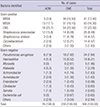1. Bluestone CD, Klein JO. Otitis media and eustachian tube dysfunction. In : Bluestone CD, Stool SE, Alper CM, Arjmand EM, Casselbrant ML, Dohar JE, Yellon RF, editors. Pediatric Otolaryngology. 4th ed. Philadelphia, PA: Saunders;2003. p. 474–685.
2. Kenna MA. Otitis media with effusion. In : Bailey BJ, Calhoun KH, Kohut RI, editors. Head and Neck Surgery--Otolaryngology: Self-assessment/Study Guide. 2nd ed. Philadelphia, PA: Lippincott-Raven;1998. p. 160–170.
3. Kubba H, Pearson JP, Birchall JP. The aetiology of otitis media with effusion: a review. Clin Otolaryngol Allied Sci. 2000; 25:181–194.
4. National Collaborating Centre for Women's and Children's Health (UK). Management of Otitis Media with Effusion in Children. London: RCOG Press;2008.
5. Daniel M, Imtiaz-Umer S, Fergie N, Birchall JP, Bayston R. Bacterial involvement in otitis media with effusion. Int J Pediatr Otorhinolaryngol. 2012; 76:1416–1422.
6. Gates GA, Klein JO, Lim DJ, Mogi G, Ogra PL, Pararella MM, Paradise JL, Tos M. Recent advances in otitis media. 1. Definitions, terminology, and classification of otitis media. Ann Otol Rhinol Laryngol Suppl. 2002; 188:8–18.
7. Westerberg BD, Kozak FK, Thomas EE, Blondel-Hill E, Brunstein JD, Patrick DM. Is the healthy middle ear a normally sterile site? Otol Neurotol. 2009; 30:174–177.
8. Poetker DM, Lindstrom DR, Edmiston CE, Krepel CJ, Link TR, Kerschner JE. Microbiology of middle ear effusions from 292 patients undergoing tympanostomy tube placement for middle ear disease. Int J Pediatr Otorhinolaryngol. 2005; 69:799–804.
9. Campos A, Arias A, Betancor L, Rodríguez C, Hernández AM, López Aguado D, Sierra A. Study of common aerobic flora of human cerumen. J Laryngol Otol. 1998; 112:613–616.
10. Stroman DW, Roland PS, Dohar J, Burt W. Microbiology of normal external auditory canal. Laryngoscope. 2001; 111:2054–2059.
11. Read AF, Woods RJ. Antibiotic resistance management. Evol Med Public Health. 2014; 2014:147.
12. Michael CA, Dominey-Howes D, Labbate M. The antimicrobial resistance crisis: causes, consequences, and management. Front Public Health. 2014; 2:145.
13. McCann MT, Gilmore BF, Gorman SP.
Staphylococcus epidermidis device-related infections: pathogenesis and clinical management. J Pharm Pharmacol. 2008; 60:1551–1571.
14. Paluch-Oleś J, Magryś A, Kozioł-Montewka M, Niedzielski A, Niedźwiadek J, Niedzielska G, Kotowski M. The phenotypic and genetic biofilm formation characteristics of coagulase-negative staphylococci isolates in children with otitis media. Int J Pediatr Otorhinolaryngol. 2011; 75:126–130.
15. Leibovitz E, Serebro M, Givon-Lavi N, Greenberg D, Broides A, Leiberman A, Dagan R. Epidemiologic and microbiologic characteristics of culture-positive spontaneous otorrhea in children with acute otitis media. Pediatr Infect Dis J. 2009; 28:381–384.
16. Brook I, Gober AE. Bacteriology of spontaneously draining acute otitis media in children before and after the introduction of pneumococcal vaccination. Pediatr Infect Dis J. 2009; 28:640–642.
17. Kim EJ, Catten MD, Lalwani AK. Detection of fungal DNA in effusion associated with acute and serous otitis media. Laryngoscope. 2002; 112:2037–2041.
18. Block SL. Causative pathogens, antibiotic resistance and therapeutic considerations in acute otitis media. Pediatr Infect Dis J. 1997; 16:449–456.
19. Wasihun AG, Zemene Y. Bacterial profile and antimicrobial susceptibility patterns of otitis media in Ayder Teaching and Referral Hospital, Mekelle University, Northern Ethiopia. Springerplus. 2015; 4:701.
20. Marchisio P, Bianchini S, Baggi E, Fattizzo M, Galeone C, Torretta S, Principi N, Esposito S. A retrospective evaluation of microbiology of acute otitis media complicated by spontaneous otorrhea in children living in Milan, Italy. Infection. 2013; 41:629–635.
21. Nasser SC, Moukarzel N, Nehme A, Haidar H, Kabbara B, Haddad A. Otitis media with effusion in Lebanese children: prevalence and pathogen susceptibility. J Laryngol Otol. 2011; 125:928–933.
22. Jung H, Lee SK, Cha SH, Byun JY, Park MS, Yeo SG. Current bacteriology of chronic otitis media with effusion: high rate of nosocomial infection and decreased antibiotic sensitivity. J Infect. 2009; 59:308–316.
23. Segal N, Leibovitz E, Dagan R, Leiberman A. Acute otitis media-diagnosis and treatment in the era of antibiotic resistant organisms: updated clinical practice guidelines. Int J Pediatr Otorhinolaryngol. 2005; 69:1311–1319.
24. Gehaanno P. Multicenter study of the efficacy and safety of oral ciprofloxacin in the treatment of chronic suppurative otitis media in adults. The French Study Group. Otolaryngol Head Neck Surg. 1997; 117:83–90.
25. Lee SK, Yeo SG, Hong SM, Sim JS, Hong CK, Lee YC, Kim SW, Cha CI. Bacteriology of chronic otitis media: changing of detection rate of methicillin-resistant Staphylococcus aureus and Pseudomonas aeruginosa
. Korean J Otorhinolaryngol-Head Neck Surg. 2008; 51:9–15.
26. Gould IM. The clinical significance of methicillin-resistant Staphylococcus aureus
. J Hosp Infect. 2005; 61:277–282.
27. Lee SH, Lee JE, Baek WY, Lim JO. Regional delivery of vancomycin using pluronic F-127 to inhibit methicillin resistant Staphylococcus aureus (MRSA) growth in chronic otitis media in vitro and in vivo. J Control Release. 2004; 96:1–7.
28. Al-Shawwa BA, Wegner D. Trimethoprim-sulfamethoxazole plus topical antibiotics as therapy for acute otitis media with otorrhea caused by community-acquired methicillin-resistant Staphylococcus aureus in children. Arch Otolaryngol Head Neck Surg. 2005; 131:782–784.









 PDF
PDF ePub
ePub Citation
Citation Print
Print



 XML Download
XML Download